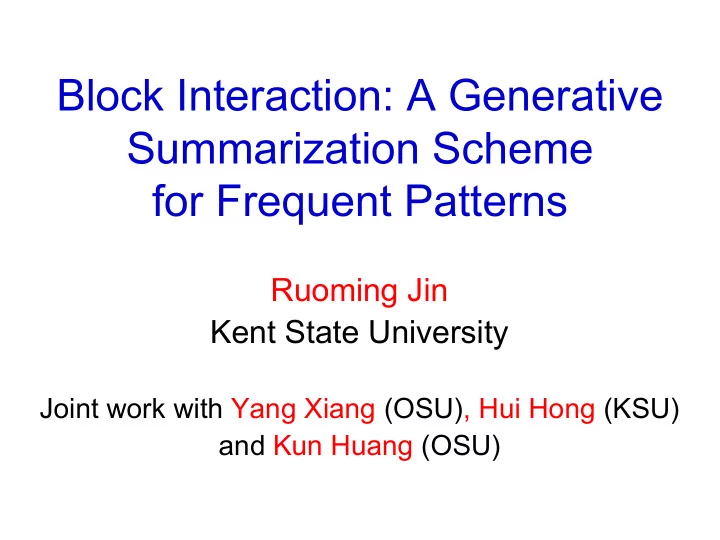

Block Interaction: A Generative Summarization Scheme for Frequent Patterns Ruoming Jin Kent State University Joint work with Yang Xiang (OSU), Hui Hong (KSU) and Kun Huang (OSU)
Frequent Pattern Mining • Summarizing the underlying datasets, providing key insights • Key building block for data mining toolbox – Association rule mining – Classification – Clustering – Change Detection – etc … • Application Domains – Business, biology, chemistry, WWW, computer/networing security, software engineering, …
The Problem • The number of patterns is too large • Attempts – Maximal Frequent Itemsets – Closed Frequent Itemsets – Non-Derivable Itemsets – Compressed or Top-k Patterns – … • Issues – Significant Information Loss – Large Size
Pattern Summarization • Using a small number of itemsets to best represent the entire collection of frequent itemsets – The Spanning Set Approach [Afrati-Gionis-Mannila, KDD04] – Exact Description = Maximal Frequent Itemsets – No support information • The problem: Can we summarize a collection of frequent itemsets and provide accurate support information using only a small number of frequent itemsets?
Itemset Contour (KDD’09) MNOVWX CDEJKL CDEVWX MNOGHI CDEGHI PQRJKL CDESTU {{GHI}, {JKL}} ABCGHI ABCSTU {{STU}, {VWX}} ⊗ {{ABC}, {CDE}} {{MNO}, {PQR}}
Generative Block-Interaction Model • Core blocks (hyper-rectangles, tiles, etc) – Cartesian products of itemsets and its support transactions • Core blocks interact with each other through two operators – Vertical Union, Horizontal Union • Each itemset and its frequency can be accurately recovered through the combination of the core blocks
Vertical Operator
Horizontal Operator
Block Support
(2X2) Block-Interaction Model
Minimal 2X2 Block Model Problem • Given the (2×2) block interaction model, our goal is to provide a generative view of an entire collection of itemsets Fα using only a small set of core blocks B.
NP-Hardness
NP-Hardness
Example
Two Stage Approach
Two Stage Approach
Algorithm Stage1: Block Vertical Union Stage2: Block Horizontal Union
Experiment • How does our block interaction model( B.I.) compare with the state-of-art summarization schemes, including Maximal Frequent Itemsets ( MFI), Close Frequent Itemsets (CFI), Non- Derivable Frequent Itemsets ( NDI), and Representative pattern ( δ -Cluster). • How do different parameters, including α and ϵ , affect the conciseness of the block modeling, i.e., the number of core blocks?
Experiment Setup • Group 1: In the first group of experiments, we vary the support level α for each dataset with a fixed user -preferred accuracy level ϵ (either 5% or 10%) and fix ϵ 1 = ϵ /2 . • Group 2: In the second group of experiments, we study how userpreferred accuracy level ϵ would affect the model conciseness (the number of core blocks). Here, we vary ϵ generally in the range from 0.1 to 0.2 with a fixed support level α and ϵ 1 = ϵ /2 . • Group 3: In the third group of experiments, we study how the distribution of accuracy level ϵ 1 in the two stages would affect the model conciseness. We vary ϵ 1 between 0.1 ϵ and 0.9 ϵ with fixed support level α and the overall accuracy level ϵ .
Data Description
Group1 Results (varying support)
Group2 Results (varying accuracy)
Group3 Results
Case Study
Questions • How does the complexity of frequent itemsets arise? • Can the large number of frequent itemsets be generated from a small number of patterns through their interactions? • Can we summarize a collection of frequent itemsets and provide support information using only a small number of frequent itemsets? • How can we evaluate the usefulness of concise patterns?
Thanks!!! Questions?
Recommend
More recommend